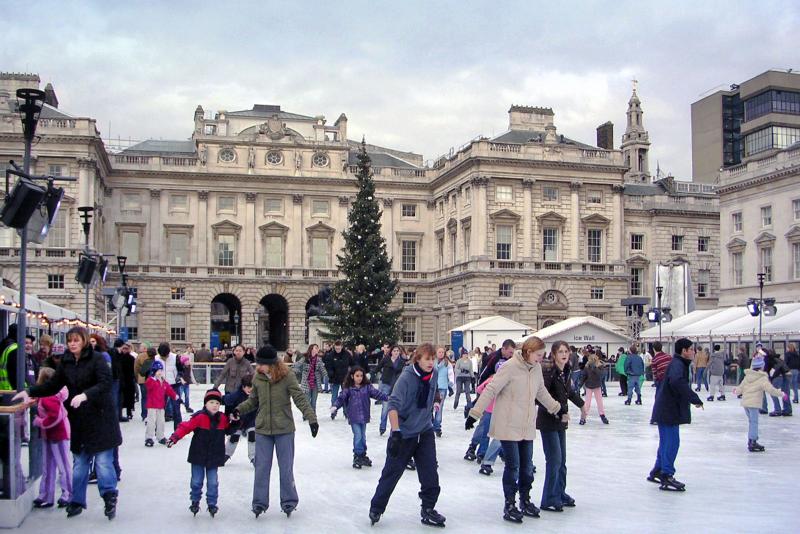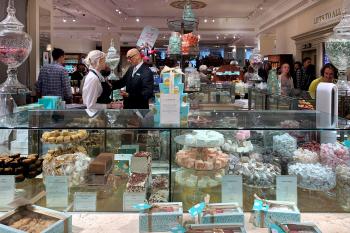Celebrating a Happy Christmas in England
Appears in the Online Edition, January 2020.
For scenes straight out of a box of old-fashioned Christmas cards, head to England. Many classic Christmas trappings, from caroling to mince pie and wassail, have been part of English tradition for centuries.
Other holiday customs have their roots in the 19th century. Queen Victoria's German husband, Prince Albert, popularized the decorating of Christmas trees and the sending of Christmas cards. Around the same time, Charles Dickens wrote A Christmas Carol -- celebrating the power of the Christmas spirit that still echoes across England today.
London and Bath are especially appealing in December. Buildings and shops are dressed in their holiday best, elaborate light displays illuminate store windows on major shopping streets, and skaters glide on outdoor ice rinks. Markets and stores fill with gourmet treats, and department stores are fun to browse even when you're done shopping. Bath also hosts an annual Christmas market in its old town; London has market stalls on Leicester Square, in Greenwich, and more -- plus a giant twinkling tree on Trafalgar Square.
Don't expect to see Santa Claus. British children visit Father Christmas, who's usually found in a grotto. In London, the poshest Father Christmas is at Harrods department store (sitting on his knee is by invitation only). But tiny tots can see him all over town, such as at the Museum of London, Greenwich Market, and Leicester Square. Father Christmas has also been known to visit the Hyde Park Winter Wonderland, which offers kitschy carnival fun with a Ferris wheel, carousel, and other rides, as well as an ice rink.
Along with wintery sights, the joy of the season is expressed in song. From street-corner buskers to sublime choral groups, the English sing their hearts out. Concerts are held everywhere from grand cathedrals and concert halls to village churches and city squares. In medieval times, carols were not just songs but also folk dances, performed by wandering musicians accompanied by singers. Considered a pagan holdover, carol singers were banned from church, so instead they'd go door to door visiting the homes of the big shots, performing in hopes of getting a coin, meal, drink, or Christmas treat.
Of course, a high point of Christmastime is the feasting. By the 16th century, mince or shred pies (a reference to the shredded meat that was mixed with chopped egg and ginger) had become a Christmas specialty. Over time the recipe was fancied up with dried fruit and other sweets, and by the 17th century, the filling closely resembled today's mix of suet, spices, and dried fruit steeped in brandy. Superstition dictates that bakers stir the filling clockwise, the direction in which the sun would have circled an earth once thought to be at the center of the universe. To stir the other way could spell big trouble in the coming year.
Plum pudding is another traditional dessert. In Victorian times on "Stir-up Sunday" at the beginning of Advent, each family member took a turn at mixing the pudding and making a wish. Then a few tiny trinkets or silver coins were tossed in the batter. (These days, most people just pop an everyday token in their "puds," but you can still buy the old-school charms: a silver coin promises wealth in the coming year, a thimble ensures thrift, an anchor assures safety, and a tiny wishbone brings good luck.) For the next few weeks, the pudding hung from a sack. On Christmas Day it was boiled until it was fully "plum" (swollen). Just before serving, it was doused with brandy, topped with a sprig of mistletoe, lit on fire, and carried to the table with great fanfare.
In cold December, hot spiced wine warms the soul. The process of mulling wine with spices can be traced back to Roman times, when winemaking included the addition of salt, myrtle, juniper, honey, rose petals, and citrus rinds. It's thought that honey and spices were added to a simmering pot of wine in the Middle Ages to mask its bitter tannins. If you were an olde Englishman drinking wassail, you would say to your companions, "Waes hail!" meaning, "May you be healthy!" The proper response? "Drink hail!" or "Drink good health!"
Another highlight of the festivities is the Christmas cracker -- invented right in London. Just as in Victorian times, kids break open these colorful paper tubes, and crack! A paper crown, a corny joke, and a teeny gift spill out with the pop. For a quieter moment on Christmas Day, many families gather around the telly to watch the Queen's annual Christmas message.
While there are plenty of special holiday happenings throughout England, there are also many closures -- including transit -- from December 24-26. Plan ahead, and give yourself time for quiet reflection. Happy Christmas!
(Rick Steves (www.ricksteves.com) writes European travel guidebooks and hosts travel shows on public television and public radio. Email him at rick@ricksteves.com and follow his blog on Facebook.)


